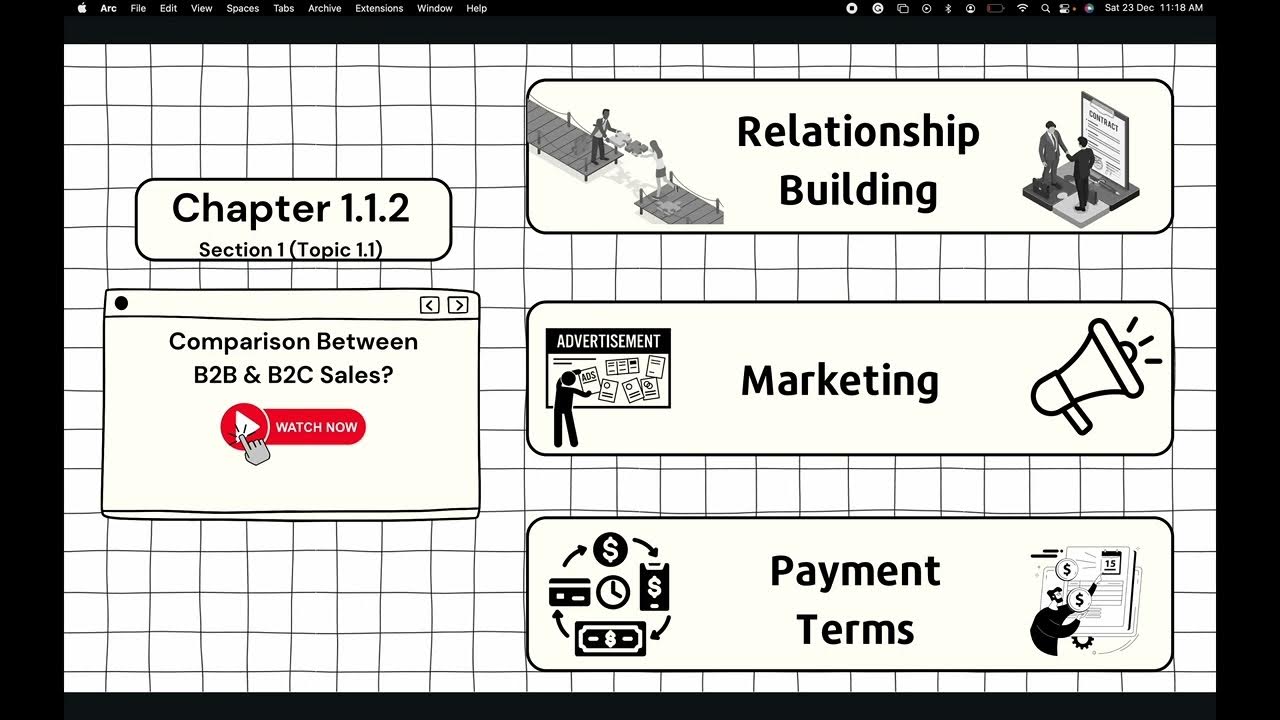B2B Digital Business Models | Chapter 9
Summary
TLDRThis chapter explores the four main B2B business models—Sourcing, Sales, Supportive Collaboration, and Service Broker—highlighting their role in digital transactions between companies. The Sourcing model emphasizes direct procurement, while the Sales model focuses on building long-term seller-buyer relationships. Supportive Collaboration drives joint efforts in R&D, production, and sales, and the Service Broker model facilitates transactions by providing information and marketplace services. The video details each model's core assets, competencies, and stages, illustrating their practical application in modern e-business environments and the synergies companies can leverage in a digital marketplace.
Takeaways
- 😀 B2B business models focus on transactions between companies, aiming to enhance efficiency and relationships.
- 😀 The 4S Net Business Model consists of four main B2B models: Sourcing, Sales, Supportive Collaboration, and Service Broker.
- 😀 Sourcing involves handling procurement transactions between buyers and sellers, using private or buy-side exchanges.
- 😀 Sales focuses on settlements initiated by the seller, fostering long-term relationships with major customers through sell-side exchanges.
- 😀 Supportive Collaboration encourages joint efforts in R&D, production, and sales to create value through partnerships.
- 😀 Service Broker facilitates B2B transactions by providing platforms for information and marketplace connections, with no direct seller-buyer relationship.
- 😀 In the Sourcing model, private exchanges support intensive supplier relationships, while buy-side exchanges enable multiple suppliers to compete for bids.
- 😀 The Sales model emphasizes creating a strong customer base, key account network, and an efficient sales platform to manage relationships and ensure long-term success.
- 😀 Supportive Collaboration benefits from integrated networks and optimized processes, like just-in-time production, through partnerships across industries.
- 😀 Service Brokers generate value by offering information portals and e-marketplaces, bridging the gap between buyers and sellers through intermediary services.
Q & A
What are the four B2B business models discussed in the video?
-The four B2B business models discussed are sourcing, sales, supportive collaboration, and service broker.
How do sourcing business models function in B2B transactions?
-Sourcing business models involve the initiation or settlement of B2B transactions between buyer and seller, focusing on procurement management via private or buy-side exchanges.
What is the difference between private B2B exchanges and buy-side B2B exchanges?
-Private B2B exchanges are one-to-one relationships between a specific buyer and supplier, fostering long-term relationships. Buy-side B2B exchanges, on the other hand, involve one-to-many relationships where a buyer invites multiple suppliers to bid, typically in a competitive e-marketplace.
What core assets are critical for the sourcing business model?
-The critical core assets for the sourcing business model include an integrated procurement system, a provider network, and an IT platform.
What role does the sales business model play in B2B transactions?
-The sales business model centers on direct transactions initiated by the seller. It focuses on managing long-term relationships between sellers and their business customers, typically through e-marketplaces or storefronts.
How do sell-side B2B exchanges operate?
-Sell-side B2B exchanges operate as web-based platforms where sellers offer products or services to a range of potential business customers. They aim to establish strong, long-term relationships with key customers.
What are the key components of the sales business model?
-Key components of the sales business model include key account management, sales execution, billing, and after-sales management. These components are designed to manage the full customer lifecycle, from relationship building to service delivery and retention.
What does the supportive collaboration business model focus on?
-The supportive collaboration business model focuses on joint efforts in research and development (R&D), production, and sales. It involves collaborative work between multiple companies to generate value and optimize operations.
What are the subcategories of the supportive collaboration business model?
-The subcategories of the supportive collaboration business model include collaborative R&D, collaborative production, and collaborative sales.
How does the service broker business model support B2B transactions?
-The service broker business model acts as an intermediary, providing information and facilitating marketplace exchanges between buyers and sellers. It does not involve direct transactions but supports businesses through information portals and e-marketplaces.
What are the core competencies required for the service broker business model?
-The core competencies for the service broker business model include skills in product proposal, customer loyalty, and the setup and management of technical infrastructure, particularly in relation to e-marketplaces and information provision.
What distinguishes e-marketplaces from information portals in the service broker model?
-E-marketplaces not only provide information but also facilitate direct transactions between buyers and sellers. Information portals, however, only provide business data without supporting direct trading between parties.
What is the key focus of the supportive collaboration business model in terms of production?
-The key focus of collaborative production in the supportive collaboration business model is to optimize production processes, often through just-in-time production and by integrating suppliers into the production chain to improve efficiency.
What assets are essential for the successful operation of the supportive collaboration model?
-The essential assets for the supportive collaboration model include a tailored IT platform and a collaboration network, which are crucial for long-term cooperation and effective resource allocation.
Outlines

This section is available to paid users only. Please upgrade to access this part.
Upgrade NowMindmap

This section is available to paid users only. Please upgrade to access this part.
Upgrade NowKeywords

This section is available to paid users only. Please upgrade to access this part.
Upgrade NowHighlights

This section is available to paid users only. Please upgrade to access this part.
Upgrade NowTranscripts

This section is available to paid users only. Please upgrade to access this part.
Upgrade Now5.0 / 5 (0 votes)





